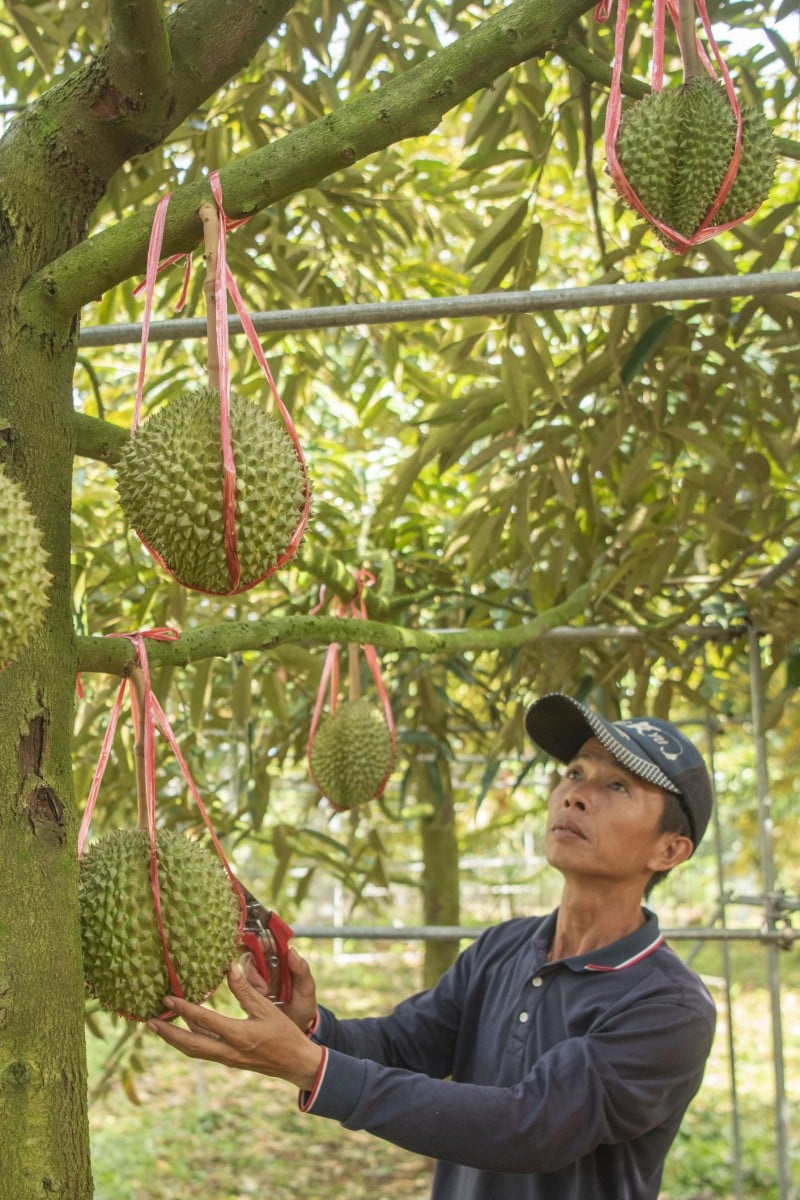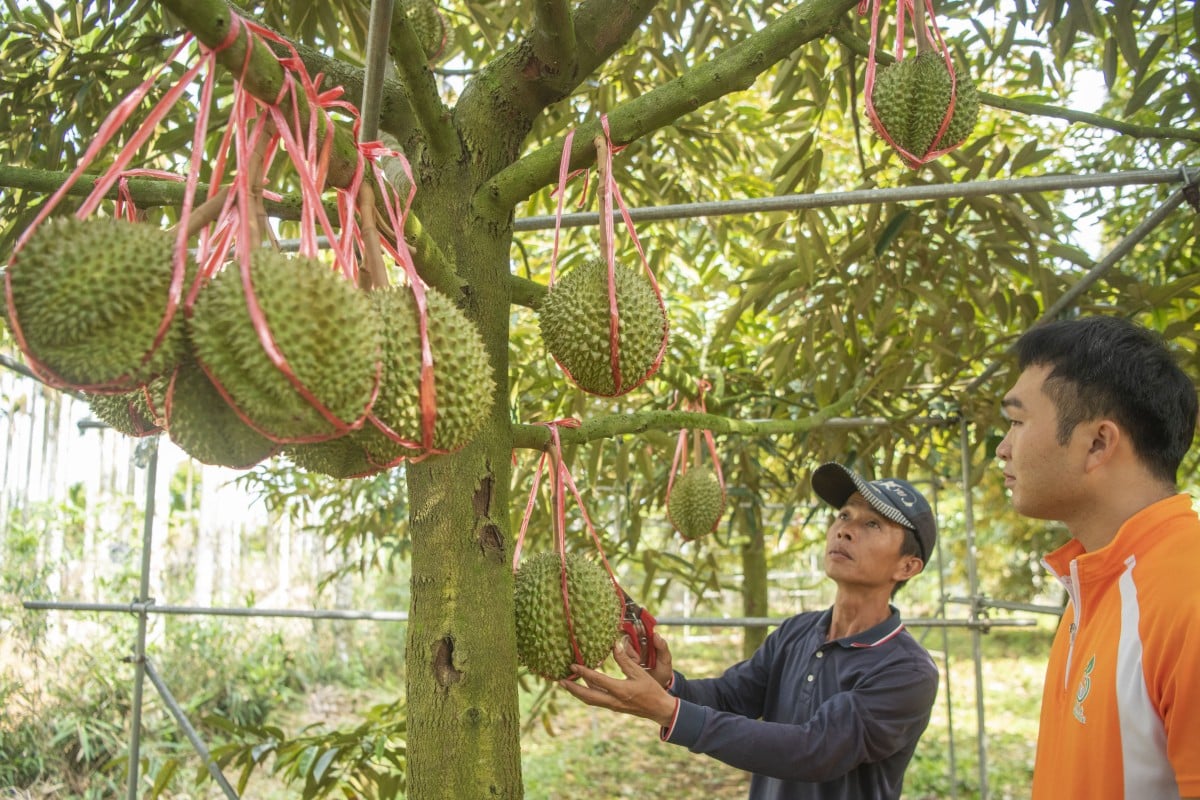
Deep Dive: China’s efforts to grow durian in tropical Hainan province
China is the largest consumer of durian worldwide, importing most from Southeast Asian countries like Thailand and Vietnam
 A worker checks the growth of Chinese durians at the “Window of the World’s Tropical Fruits”, a modern agricultural industrial park, on July 27, 2023 in Qionghai, Hainan, China. Photo: VCG/VCG via Getty Images
A worker checks the growth of Chinese durians at the “Window of the World’s Tropical Fruits”, a modern agricultural industrial park, on July 27, 2023 in Qionghai, Hainan, China. Photo: VCG/VCG via Getty ImagesDeep Dive delves into hot issues in Hong Kong and mainland China. Our easy-to-read articles provide context to grasp what’s happening, while our questions help you craft informed responses. Check sample answers at the end of the page.
News: Finding the right recipe to grow durian in Hainan
-
China consumes about 85 per cent of the world’s durian supply annually, importing it from Southeast Asia
-
Efforts are under way to grow the fruit in Hainan, China’s tropical southernmost province
Every day from dawn to midnight, Huang Qijun nurtures and tends to 10,056 durian trees in Hainan.
The nearly 40-hectare (99-acre) durian orchard is mostly managed by only one caretaker, and much of the work is handled by machines. Each tree is equipped with sensors that monitor temperature and humidity. When one needs water, Huang receives an alert on his smartphone. With a simple tap of the app, towering irrigation sprinklers beside the tree activate instantly.
Standing at the centre of China’s home-grown durian industry, trees in Huang’s plantation are less than five years old. This is much younger than the decades- or centuries-old farms common in Southeast Asian countries.
Du Baizhong, general manager of the Hainan Youqi Agricultural Company, said, “For Chinese durians, there’s only one path forward: we must focus on producing high-quality products.”
“Hainan can learn from Japan. Japan has a relatively small land area, so they prioritise quality above all else in agricultural development.”
Deep Dive: Hong Kong workers say they are losing jobs under labour import scheme
Du explained that the key to premium quality durians is tree-ripening. This means the fruits are left to fully mature on the branch until they drop naturally. Made-in-Hainan means ripened durians do not need to go through customs clearance and can freshly arrive at customers around the country within 48 hours by air. The peak flavour lasts only 3-4 days after harvest, with quality noticeably declining every day after that, Du said.
Most durians from Southeast Asia – primarily from Thailand – are picked at 60 to 70 per cent maturity and then artificially ripened with chemicals, he said. While this extends their shelf life, it sacrifices quality. It triggers an uneven texture and enhances the fruit’s infamous smell that deters many. It is not true durian aroma, but ethylene by-products, he explained.
China consumes more than 85 per cent of the world’s supply of durians annually. However, there was a long-held belief in Hainan that the country’s only tropical province was unsuitable for growing durians, despite the region’s similar latitude to Southeast Asia. Previous large-scale cultivation efforts all failed, though some individual trees planted in household backyards did bear fruit.
The main reason lies in monsoons deeply influencing the island’s weather, making it more unpredictable in terms of temperature and rain, shifting between sunshine and storms. That is not ideal for durian trees, which need a more stable climate.
Staff writer
Question prompts
1. Using the information in News, which of the following is true?
(1) Huang manages the durian orchard largely with the use of technology.
(2) Most of Huang’s durian trees are more than 10 years old.
(3) Du says that China can learn from Japanese orchards, which focus on quantity.
(4) Durians from Thailand are picked at 60 to 70 per cent maturity.
A. (1), (3) only
B. (1), (4) only
C. (2), (3) only
D. (3), (4) only
2. Using the information in News, list TWO reasons why China is the main consumer of durian but not the main producer.
3. Why might locally-grown durians be more appealing to customers in China, despite fewer orchards compared to Southeast Asia? Explain using News and your own knowledge.
Cartoon
Question prompts
1. What is being depicted in this cartoon?
2. How does this cartoon relate to the points made in News?
Issue: Domestically-grown durians can’t meet demand in China
-
Though investors are pouring money into Chinese durian farms, imports are still high
-
Prices of locally-grown fruits can be double those imported from countries like Thailand
The arrival of home-grown durians on Chinese shelves has already sparked a gold rush for tropical agriculture in the world’s largest durian market, with investors pouring capital into young durian farms in China.
It marks China’s leap from a pure importer to a grower, creating ripples in the global trade of the fruit. In recent years, Beijing has opened its markets to more countries, importing fresh durians from around the region in a move dubbed “durian diplomacy”, spurred by the growing appetite of Chinese durian lovers and Beijing’s wish to cement its ties with Southeast Asia.
But Du Baizhong, general manager of the Hainan Youqi Agricultural Company, said the idea of domestic durians replacing imports would be wishful thinking. The company is the first and biggest durian grower in China, with more than 200,000 durian trees in Hainan.
“Southeast Asia probably doesn’t need to care about China’s small-scale cultivation because we are not a real competitor,” Du said. “Even if the entirety of Hainan Island were planted with durians, it still couldn’t meet the massive domestic demand in our country.”
China’s fresh durian imports have hit record highs in volume for four consecutive years. In 2024, imports totalled 1.56 million tonnes, worth nearly US$7 billion (HK$54.6 billion), according to data from China Customs.
Deep Dive: In the new ‘space race’, US and China compete to produce humanoid robots
For years, Thailand dominated China’s demand for fresh durian as the sole approved exporter – until 2022, when Vietnam broke the monopoly. The market further expanded with the Philippines gaining access in 2023 and Malaysia in 2024.
Domestically produced durians simply cannot compete with Southeast Asia in terms of yield and price, given the scarce growing experience, more volatile climate and higher labour costs, said Du. Last year, the price of home-grown “golden pillow” durians doubled those imported from Thailand.
Currently, Du’s tallest durian trees are around 7 metres (23 feet) tall. In mature Southeast Asian plantations, trees reach as high as 30 metres (128 feet).
In China, as concerns over economic growth mount, few industries now give insiders the same promising feeling as that of durian farming.
Some industry investors are setting their sights on the mainland, with a new darling area being Xishuangbanna. It is a small and tropical region in the southwestern province of Yunnan, though it is still unclear whether the area can be industrialised as successfully as Hainan.
Staff writers
Question prompts
1. According to Issue, which of the following is true?
(1) China imported 1.2 million durians in 2023.
(2) Thailand was the sole exporter of durians to China until Malaysia broke into the market in 2020.
(3) Mature durian trees in Southeast Asia can be as tall as 30 metres.
(4) Xishuangbanna in Yunnan may soon be home to many durian orchards.
A. (1), (2) only
B. (2), (3) only
C. (1), (4) only
D. (3), (4) only
2. List TWO reasons why Du says Southeast Asia does not need to worry about China competing in the durian market.
3. According to Issue, “few industries now give insiders the same promising feeling as that of durian farming” in China. Why do you think investors in China are focusing on this market, and what are some potential risks? Explain using News, Issue and your own knowledge.
Graph
Question prompts
1. Note TWO trends depicted in the graph.
2. Using Issue and your own knowledge, list TWO things that could happen if China began to match Thailand’s durian production.
Glossary
irrigation: the process of supplying water to land or crops. It is usually done through channels designed for efficient distribution. There are various types of irrigation, such as surface irrigation, sprinkler irrigation, and subirrigation, where water is supplied from below the ground’s surface.
customs clearance: the process of ensuring that goods entering or leaving a country comply with regulations, taxes, and duties before being transported.
ethylene: a flammable hydrocarbon gas. It occurs in natural gas, coal gas, and crude oil. It is also released by ripening fruit and acts as a plant hormone, which can induce fruit ripening.
cultivation: the act of caring for or raising plants
diplomacy: the practice of managing international relationships through negotiation and strategy. It involves representatives from various countries working together to resolve conflicts and create alliances.
monopoly: to have complete control of something, especially an area of business, so that others have no share
Sample answers
News
1. B
2. According to News, China consumes 85 per cent of all durian grown across the globe, which likely can be attributed to the popularity of the fruit as well as China’s massive population.
However, as News reveals, China’s climate is not suitable for adequate durian growth, even in Hainan, which is on a similar latitude to Southeast Asia. This is because durians need a stable climate, but the volatile weather in Hainan makes it unfavourable for durian orchards.
3. Durians grown in Hainan would be picked fresh, and customers would get great quality fruit. However, durians from Southeast Asia are artificially ripened with chemicals to extend their shelf life in time for importation. This makes the texture uneven and accentuates the strong smell. Additionally, locally grown products could be cheaper compared to imported goods from Southeast Asia. Finally, supporting domestic orchards would contribute to the local economy.
Illustration
1. This cartoon shows two people looking at a durian grown in China, according to the words on the pedestal. Behind the people are buckets and buckets of durians from Southeast Asian nations including the Philippines, Vietnam, and Thailand.
2. This cartoon shows a single durian from China, but many from Southeast Asia. This shows that, while the majority of durians are grown in Southeast Asia, the Chinese are still fascinated by the idea of local durian orchards, though they are fewer in quantity so far.
Issue
1. D
2. Du said that China will not be able to meet its domestic consumer needs, even if it were able to harness all available land in Hainan and other tropical regions. Given the high volume produced in Thailand and the ideal durian-growing climate in Southeast Asia, China would struggle to break into the market.
3. Investors are excited about the durian industry because of the high demand for durian in China. There will always be more demand than supply, so nothing will go to waste. Additionally, investors in durian orchards will not have to deal with importing costs and logistics. However, the volatile weather and climate in southern China might mean that some seasons do not yield as many durians as projected, which could be a risk for investors. Additionally, competing with the already-established and successful markets in Southeast Asia would be difficult.
Graph
1. This graph shows China’s total imports of durian, split by country. According to the graph, the vast majority of durian imports have come from Thailand in the last five years. It was not until 2023 that other Southeast Asian countries – primarily Vietnam – began to compete in the durian market. Malaysia and the Philippines also export to China, but in much smaller quantities.
2. If China suddenly became a competitor in the durian market, it could boost the economy and create jobs, though it may also crush the markets and economy in Southeast Asia (accept all reasonable answers).
